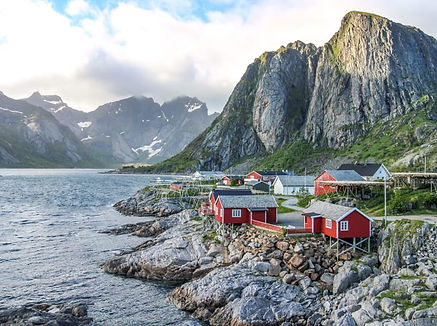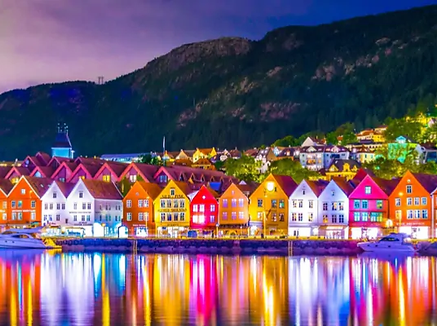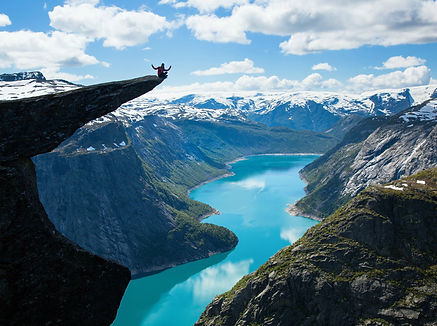ATTRACTIONS
The Lofoten Islands
Lofoten is shaped like a big arm that stretches out in the sea. The many mountain peaks point towards the Arctic sky like church spires, and in between them you’ll find traditional villages full of fishermen and artists. It is also easy to travel to the mainland, or to Helgeland and the UNESCO-listed Vega archipelago further south.
Bergen
The hometown of one of the world's most popular music creators, Kygo, sounds, feels, and tastes like nothing else. Fresh seafood and other local delicacies match a bustling art scene of museums and galleries. The streets of this capital of the fjords is full of wooden, fairy tale houses with the seven mountains as a backdrop. The medieval Hanseatic wharf of Bryggen, with its around 60 historic buildings in succession, is on the UNESCO World Heritage list and several foundations date back to the 12th century.
Tromsø
A few main streets manage to create an urban, international vibe – polar style. The city on the peninsula of Tromshalvøya justifies the nickname “capital of the Arctics”. It has a multitude of things to do and see, ranging from the Polaria Centre, The Polar Museum, and the local Mack brewery established I 1877, to whale spotting, midnight sun, and northern lights. Tromsø is the largest city in Northern Norway. None the less, the surrounding steep mountains and deep fjords are so close to the city centre that you can admire them from the main street.
Oslo
A capital in the middle of nature, Oslo is selected for the European Green Capital of 2019 and listed by Lonely Planet as Best in Travel for 2018. A lot of things are cooking in the city, like a restaurant scene that includes the world’s northernmost three-star Michelin restaurant. Oslo is also home to some of the most awarded baristas and coffee brewers on the planet.
The Geirangerfjord
The Seven Sisters and numerous other waterfalls run down steep mountain sides that end in the clear, blue water of the 15 kilometres long Geirangerfjord. Here, you’ll find the natural peace and quiet of one of the world’s top nature attractions.
Listed as a UNESCO World Heritage site. The immediate surrounding regions also have a lot to offer the whole year round.
The Svalbard Islands
This huge island group in the northernmost part of Europe takes wildlife to next level, and at the same time the society is very well organised. Here you can participate in exotic, nature based activities, all year round.
The main city of Longyearbyen is a mini metropole because it offers services and very good places to eat that you usually would expect to find in big cities.
Flåmsbana
A 20 kilometres long mountain railway journey takes you through the beautiful landscapes of the innermost part of the Aurlandsfjord, an arm of the Sognefjord.
Keep in mind that one of the most travelled sites in Norway is far less busy and crowded in spring, autumn, or even early summer.
Trondheim
Lively, pedestrian-friendly streets with colourful wooden buildings lead to the Nidaros cathedral and the old warehouses along the Nidelven river. Trondheim also has plenty of cool cafés, and a fresh restaurant scene is keen to exploit and renew the richness of the typical local food of the Trøndelag region.
Food markets and festivals adds to the good mood, and music stands strong in this city with the Rockheim and Ringve musical museums.
The Stavanger region
50 years as Norway’s oil capital hasn’t spoiled the charm of this seaside city, nor has it changed the fact that the region has some of Norway’s main hiking attractions.
Here, you can explore the Lysefjord area and famous mountains plateaus like Preikestolen (“The Pulpit Rock”). Local food is served at both Michelin-starred restaurants and likewise ambitious, but more low-key eateries.
The Sognefjord area
The Sognefjord is Norway’s longest and deepest fjord and extends from the coast just north of Bergen to the mighty mountains of the Jotunheimen National Park and the blue ice of the Jostedalsbreen glacier.
The approximately 30,000 inhabitants in the area live together in small, villages along the fjords and in the valleys. In addition to providing visitors with enjoyable experiences, Sognefjorden wishes to preserve the local nature, culture and environment, strengthen social values, and be economically viable.








